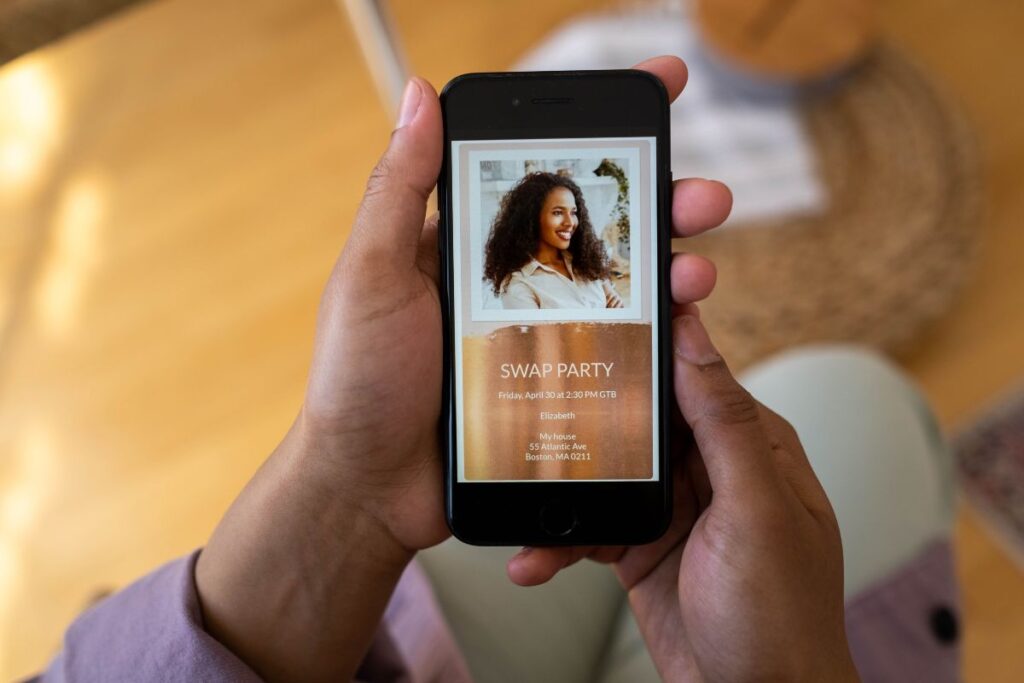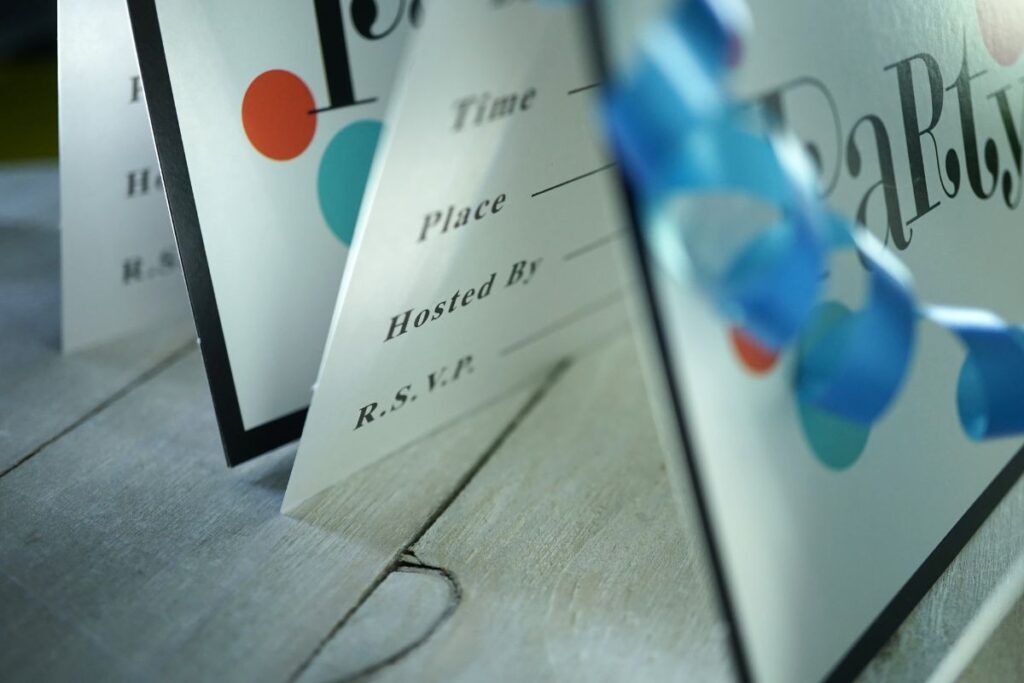In today’s world, there are countless ways to invite guests to your event, each with its own set of advantages and considerations. Whether you’re planning an elegant wedding, a casual barbecue, or a birthday bash, the invitation you choose sets the tone and helps build excitement for what’s to come.
But with so many options—from traditional snail mail to modern digital invites—how do you decide which is best for your occasion? This guide breaks down the pros and cons of each option, offering recommendations to help you make the best choice for your next gathering.
Traditional Invitations: The Classic Snail Mail
When it comes to setting the tone for a formal event, nothing quite matches the elegance and timelessness of a traditional paper invitation. From the texture of the paper to the intricacy of the design, printed invitations offer a tangible, personal touch that digital options often can’t replicate. Perfect for weddings, milestone celebrations, or any event where you want to make a lasting impression, snail mail invitations are a cherished keepsake for both hosts and guests alike. However, with the beauty and sentimentality of traditional invitations comes the need for careful planning, attention to detail, and sometimes a bit of extra time and budget.

⭐ Pros:
Tangible Keepsake: A beautifully designed invitation can be a cherished memento for both you and your guests, especially for significant events like weddings or milestone birthdays.
Formal Tone: Printed invitations immediately convey a sense of formality and importance, making them ideal for upscale events.
Personal Touch: Physical invitations often feel more personal, especially when they include handwritten notes or unique embellishments.
⭐ Cons
Time-Consuming: Designing, printing, and mailing invitations requires significant lead time. You’ll need to plan well in advance to ensure everything arrives on time.
Costly: The cost of paper, printing, and postage can add up, especially if you’re inviting a large group.
Environmental Impact: Traditional invitations contribute to paper waste, which may be a consideration for eco-conscious hosts.
⭐ Best For:
Weddings, formal parties, milestone celebrations, or events where a tangible keepsake adds to the experience.
⭐ Recommendations:
DIY Tools: For those who want a hands-on approach, consider using Canva or Adobe Express to design your own invitations. Both offer a range of templates and customization options.
Professional Services: For a polished, professional finish, Minted and Shutterfly offer custom designs, high-quality paper, and even mailing services.
Printing Services: If you have a design ready, VistaPrint and Paper Source are great options for affordable, high-quality printing.
Digital Invitations: The Modern Approach
In our fast-paced, tech-savvy world, digital invitations have become the go-to choice for many hosts looking for a quick, efficient, and environmentally friendly way to gather guests. With just a few clicks, you can create a stylish, interactive invitation that not only delivers instantly but also allows you to track RSVPs, send reminders, and even share event updates. Digital invitations are perfect for casual get-togethers, last-minute plans, or any event where convenience and accessibility are key. However, while they offer many advantages, it’s important to consider how they might be perceived by your guests and whether they suit the style of your event.

⭐ Pros:
Instant Delivery: Digital invitations are sent and received instantly, making them perfect for last-minute events or when time is of the essence.
Interactive Features: You can include interactive elements like maps, links to gift registries, or RSVP tracking. Reminders and updates are also easy to send.
Cost-Effective: Most digital invitation services are free or low-cost, and you’ll save on printing and postage.
Eco-Friendly: No paper waste means digital invitations are a more sustainable option.
⭐ Cons:
Perceived Informality: Digital invitations may come across as less formal, which might not be ideal for all events.
Digital Divide: Not all guests may be comfortable with or have access to digital invitations, particularly older attendees.
Spam Risk: Emails can sometimes end up in spam folders, so you may need to follow up to ensure everyone received the invitation.
⭐ Best for:
Casual gatherings, modern celebrations, or any event where ease and interactivity are prioritized.
⭐ Recommendations:
Evite: A popular and user-friendly platform with a wide range of free and premium designs.
Paperless Post: Offers beautifully designed digital invitations with customization options that rival traditional paper invites.
Greenvelope: An eco-friendly option that donates a portion of each sale to environmental causes and provides sophisticated designs.
Punchbowl: Includes RSVP tracking, event reminders, and the ability to add links, perfect for busy hosts.
Hybrid Approach: The Best of Both Worlds
For those who want the tangible feel of a printed invitation with the convenience of digital features, consider a hybrid approach. You can send out traditional invitations but include a link to a digital RSVP or event page where guests can access additional details, updates, or even directions.

⭐ Best for:
Hosts who want to maintain formality while benefiting from digital convenience.
⭐ Recommendations:
Zazzle: Allows for the integration of digital elements within traditional invitation designs.
Mixbook: Offers the ability to create a printed invitation with a QR code that directs guests to a digital event page.
Additional Considerations
As you finalize your invitation plans, a few extra details can make all the difference in ensuring your event goes off without a hitch. Beyond the choice between traditional and digital invitations, factors like whether to request RSVPs, how to set the tone with specific wording, and even the ideal timing for sending your invites can all impact the success of your gathering. These small yet important decisions can help you create a more seamless and enjoyable experience for both you and your guests.
- RSVP Options:
- Snail Mail RSVP: Traditional, but requires extra postage and time.
- Digital RSVP: Convenient and efficient, especially for large events.
- Event Details:
- Start and End Time: Clearly stating the start and end times can help set expectations, especially for events that might run late. This small details helps guests plan their evening.
- Dress Code: Whether it’s casual, cocktail, or costume, specifying the dress code ensures guests are prepared and reduces any “what to wear” anxiety.
- Plus Ones and Children: Clearly indicate whether guests can bring a plus one or children to avoid any confusion.
- Personal Touch:
- Handwritten Notes: Add a handwritten note to your printed invites for a more personal feel.
- Custom URLs: Use a custom URL for your event page to make it easy for guests to find details and RSVP.
Conclusion
Choosing the right type of invitation for your event depends on a variety of factors, including the formality of the occasion, your budget, and the preferences of your guests. Whether you opt for the timeless charm of a traditional printed invitation or the convenience of a digital invite, the key is to ensure that it reflects the tone and style of your event.
By considering the pros and cons of each option and using the recommended services and tools, you can create invitations that not only set the stage for your event but also make the planning process smoother and more enjoyable.

